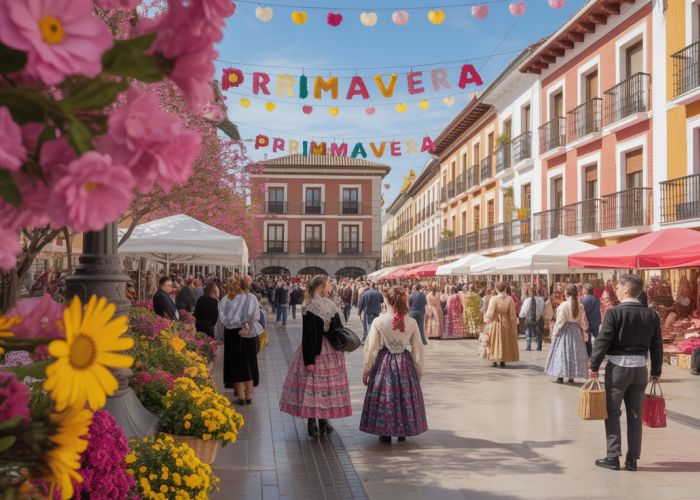The arrival of spring, a season celebrated across cultures, finds its vibrant expression in the Spanish word primavera. Understanding the spanish primavera etymology offers a fascinating glimpse into the evolution of language and culture. For instance, Etymology itself, the study of word origins, reveals that primavera’s roots extend deep into Latin. The concept of springtime festivals like the Roman Floralia, which marked the renewal of life and fertility, provides cultural context. Even the famed artist Sandro Botticelli, through his iconic painting ‘La Primavera,’ captured the essence of spring’s beauty, reflecting the cultural significance woven into the word. Moreover, learning about linguistics can give a fresh understanding of spanish primavera etymology.

Unveiling Primavera’s Origins: A Deep Dive into Spanish Etymology
The word "primavera" evokes images of blooming flowers, fresh breezes, and the vibrant energy of spring. But have you ever wondered where this beautiful word comes from? We’re going to unlock the secret behind the spanish primavera etymology and explore its roots within the Spanish language and broader Romance languages.
The Literal Meaning and Initial Breakdown
At its heart, primavera translates directly to "spring" in Spanish. To understand the spanish primavera etymology, we need to break the word down into its constituent parts and trace their historical evolution.
- The word isn’t a single, unbreakable unit. Instead, it’s a product of centuries of linguistic development.
- We’ll start by dissecting the most obvious components and then delve into their deeper connections.
Tracing the Roots: Latin and Beyond
The spanish primavera etymology leads us directly to Latin, the ancestor of Spanish and many other Romance languages. The key here lies in identifying the relevant Latin words.
- "Prima" (First): This is the most readily apparent component. "Prima" in Latin signifies "first," "early," or "primary." Think of words like "primary" or "prime" in English – they all share this same Latin root.
- "Vera" (Spring): This part is a bit more nuanced. While "vera" doesn’t directly translate to "spring" in classical Latin, it’s connected to the concept of youth and newness.
"Prima" and its Significance
The inclusion of "prima" highlights the spring season as the first among seasons in a particular way, especially when considering agricultural cycles. Consider these points:
- The first blooms after winter signal the renewal of life.
- The "first" harvest of the year often occurs during springtime.
- Ancient cultures often celebrated spring as the beginning of a new year.
Decoding "Vera": From Youth to Season
The path from the Latin roots associated with youth ("ver") to the Spanish "vera" as a part of primavera requires a bit more digging. The connection lies in the association between youth and freshness, growth, and the new beginning that spring represents. Think about the word "vernal" in English (relating to spring): this derives directly from the Latin "ver" which connects with "youth."
-
Consider these etymological connections:
Latin Word Meaning Related English Word ver Spring, youth Vernal veris (gen.) Of spring veranus Relating to spring -
The Vulgar Latin form (the spoken Latin used by common people, which eventually evolved into the Romance languages) likely saw a shift in usage, gradually linking "ver" and its derivatives specifically with the spring season.
The Evolutionary Journey: From Latin to Spanish
Understanding the spanish primavera etymology isn’t just about identifying the Latin roots; it’s about tracing how those roots transformed into the modern Spanish word.
- Latin Influence: The foundations were laid in Latin, with its emphasis on "first" and the association of youth with the spring season.
- Vulgar Latin Adaptation: As Latin evolved into different dialects, the specific combinations of words and their meanings shifted slightly. The association of spring with "ver" likely became more pronounced in the Iberian Peninsula.
- Phonetic Changes: Sounds evolved over time. Latin vowel and consonant sounds subtly morphed within the developing Spanish language. These changes influenced the pronunciation of "prima" and "vera."
- Consolidation: Over centuries, the phrase "prima vera" coalesced into a single word representing the season of spring.
Cross-Linguistic Comparisons: Primavera’s Romance Cousins
The spanish primavera etymology isn’t an isolated case. Many other Romance languages share similar words for "spring," demonstrating their common Latin heritage.
- Italian: Primavera – directly inherited from Latin.
- Portuguese: Primavera – closely related, exhibiting only minor phonetic variations.
- French: Printemps – While not as directly connected to "prima" and "vera," it still conveys the idea of the "first time" (Latin tempus) of the year.
- Romanian: Primăvară – again a very close cognate.
The widespread use of variations of "primavera" across the Romance languages is strong evidence of the word’s deep roots in Latin and its subsequent evolution within each language family.
Unlocking Primavera: Your Spanish Etymology Questions Answered
Hopefully, this FAQ clarifies some common questions about the fascinating etymology of "Primavera" in Spanish.
What does "Primavera" actually mean?
"Primavera" simply means "spring" in Spanish. It refers to the season after winter and before summer, known for its blooming flowers and warmer weather.
Where does the word "Primavera" originate?
The word has Latin roots. "Primavera" comes from the Latin phrase "prīma vēra," which translates to "first spring" or "early spring." This highlights the season’s position as the beginning of new growth.
Is the etymology of "spanish primavera" linked to any myths?
While not directly linked to specific myths in its etymology, "spring" seasons often carry symbolic weight of rebirth and renewal in various mythologies. The “prima” or “first” aspect aligns with ideas of beginnings.
Are there any other Spanish words related to the etymology of "spanish primavera"?
Related words include variations emphasizing the early or first aspects of spring. The base word, "prīma" meaning first, can be found in other Spanish vocabulary referring to primacy or beginnings.
So, there you have it! Hopefully, diving into the spanish primavera etymology was as refreshing as a spring breeze. Now you know a little more about why we say ‘primavera’! Happy spring!



